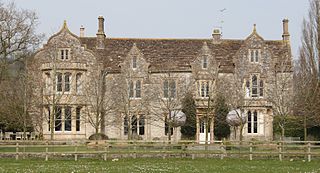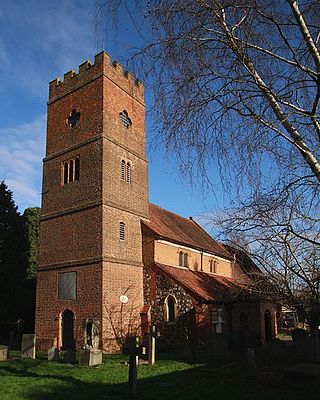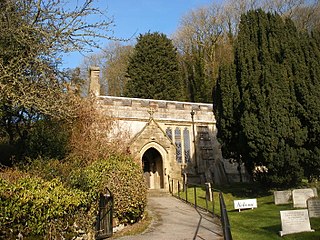
Bakewell is a market town and civil parish in the Derbyshire Dales district of Derbyshire, England, known for Bakewell pudding. It lies on the River Wye, 13 miles (21 km) south-west of Sheffield. At the 2011 census, the population of the civil parish was 3,949. It was estimated at 3,695 in 2019. The town is close to the tourist attractions of Chatsworth House and Haddon Hall.

The history of Derbyshire can be traced back to human settlement since the last Ice Age, over 10,000 years ago. The county of Derbyshire in England dates back to the 11th century.

Stretton en le Field is a small village and civil parish in the North West Leicestershire district of Leicestershire, England, about 7 miles/11 km south-west of Ashby de la Zouch, historically an exclave of Derbyshire. According to the 2001 census, the parish had a population of 36. At the 2011 census the population remained under 100 and so was included in the civil parish of Chilcote. Stretton Bridge carries the A444 road across the River Mease, which forms the northern parish boundary. It is among the Thankful Villages, suffering no Great War fatalities in 1914–1918: eleven men went from the village to fight and all returned.

Atlow is a village and civil parish in the Derbyshire Dales district of Derbyshire, England, about eight miles west of Belper. According to the 2001 census the parish had a population of 98. At the 2011 Census the population remained less than 100. Details are included in the civil parish of Hognaston.

Lamas is a village in Broadland, Norfolk, England. Administratively it falls within the civil parish of Buxton with Lamas.

The Abbey, Ditcheat is a large house at Ditcheat in Somerset. Originally a rectory, now converted into a house, the Grade II* listed building dates from the 15th century. To the rear of the Abbey is a Grade II listed granary.

Church Gresley is a large village and former civil parish in the South Derbyshire district of Derbyshire, England. The village is situated between Castle Gresley and the town of Swadlincote, with which it is contiguous. By the time of the 2011 Census the village was a ward of Swadlincote, of which it is now effectively a suburb, and the population of Church Gresley ward was 6,881. The village forms part of the border with Leicestershire to the southeast. Nearby villages include Castle Gresley, Albert Village, Linton and Overseal.

The Priory Church of St Peter with its monastery was founded in 1132 by Henry I for Augustinian Canons in Dunstable, Bedfordshire, England. St Peter's today is only the nave of what remains of an originally much larger Augustinian priory church. The monastic buildings consisted of a dormitory for the monks, an infirmary, stables, workshops, bakehouse, brewhouse and buttery. There was also a hostel for pilgrims and travellers, the remains of which is known today as Priory House. Opposite the Priory was one of the royal palaces belonging to Henry I, known as Kingsbury.

Norbury Manor is a 15th-century Elizabethan manor house and the adjoining 13th-century stone-built medieval hall house, Norbury Hall, known as The Old Manor in Norbury near Ashbourne, Derbyshire. It is a Grade I listed building.

Littleton is a village in the Borough of Spelthorne, approximately 16 mi (26 km) west of central London. Historically part of the county of Middlesex, it was transferred to Surrey in 1965. It is the location of Shepperton Studios.

Norbury is a village in Derbyshire, England. It is located 3 miles (4.8 km) north of Rocester, on the B5033 road and the River Dove. The hamlet has links with George Eliot's family, the Evans. George Eliot's father, Robert Evans, was born in Roston Common and sang in the choir at Norbury church, and most of George Eliot's paternal ancestors are buried there.

Bradbourne Priory was a priory in Bradbourne, Derbyshire, England.

Gresley Priory was a monastery of Augustinian Canons regular in Church Gresley, Derbyshire, England, founded in the 12th century.
Albert Hartshorne was an English archaeologist.

Callow Hall Hotel is a house of historical significance in Derbyshire, England. It lies 0.5 mile west of the town of Ashbourne, within the civil parish of Mapleton. It was built from 1849 to 1852 by H. J. Stevens for John Goodwin Johnson, a local magistrate. It was a private residence for over a century and then became a hotel in 1982. It is still a hotel which provides accommodation and restaurant services and caters for special events particularly weddings.

St Margaret's Church, Carsington, is a Grade II* listed parish church in the Church of England in Carsington, Derbyshire.

All Saints’ Church, Bradbourne is a Grade I listed parish church in the Church of England in Bradbourne, Derbyshire.
Bradbourne is a civil parish in the Derbyshire Dales district of Derbyshire, England. The parish contains 16 listed buildings that are recorded in the National Heritage List for England. Of these, one is listed at Grade I, the highest of the three grades, one is at Grade II*, the middle grade, and the others are at Grade II, the lowest grade. The parish contains the village of Bradbourne and the surrounding countryside. The listed buildings consist of houses, cottages and associated structures, farmhouses and farm buildings, a church and items in the churchyard, and a former watermill and associated buildings.



















